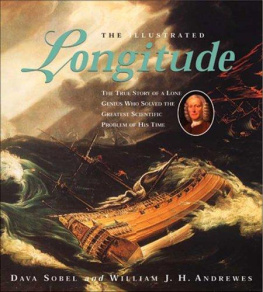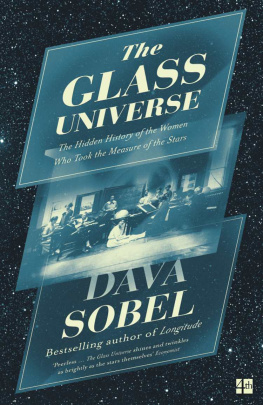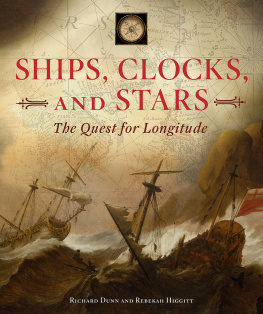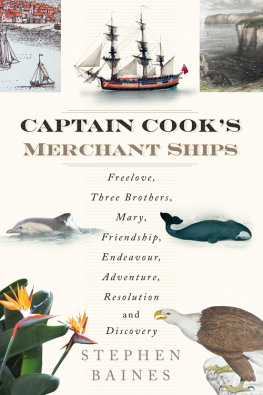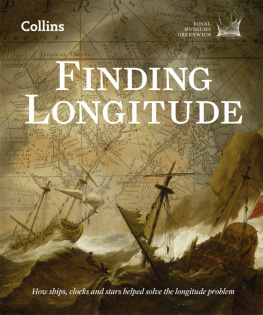LONGITUDE
The
True Story of a
Lone Genius
Who Solved
the Greatest
Scientific Problem
of His Time

DAVA SOBEL
Contents

For my mother,
Betty Gruber Sobel,
a four-star navigator
who can sail by the heavens
but always drives by way of Canarsie.
Imaginary Lines
When Im playful I use the meridians of longitude and parallels of latitude for a seine, drag the Atlantic Ocean for whales. MARK TWAIN , Life on the Mississippi
O nce on a Wednesday excursion when I was a little girl, my father bought me a beaded wire ball that I loved. At a touch, I could collapse the toy into a flat coil between my palms, or pop it open to make a hollow sphere. Rounded out, it resembled a tiny Earth, because its hinged wires traced the same pattern of intersecting circles that I had seen on the globe in my schoolroom the thin black lines of latitude and longitude. The few colored beads slid along the wire paths haphazardly, like ships on the high seas.
My father strode up Fifth Avenue to Rockefeller Center with me on his shoulders, and we stopped to stare at the statue of Atlas, carrying Heaven and Earth on his.
The bronze orb that Atlas held aloft, like the wire toy in my hands, was a see-through world, defined by imaginary lines. The Equator. The Ecliptic. The Tropic of Cancer. The Tropic of Capricorn. The Arctic Circle. The prime meridian. Even then I could recognize, in the graph-paper grid imposed on the globe, a powerful symbol of all the real lands and waters on the planet.
Today, the latitude and longitude lines govern with more authority than I could have imagined forty-odd years ago, for they stay fixed as the world changes its configuration underneath themwith continents adrift across a widening sea, and national boundaries repeatedly redrawn by war or peace.
As a child, I learned the trick for remembering the difference between latitude and longitude. The latitude lines, the parallels , really do stay parallel to each other as they girdle the globe from the Equator to the poles in a series of shrinking concentric rings. The meridians of longitude go the other way: They loop from the North Pole to the South and back again in great circles of the same size, so they all converge at the ends of the Earth.
Lines of latitude and longitude began crisscrossing our worldview in ancient times, at least three centuries before the birth of Christ. By A.D. 150, the cartographer and astronomer Ptolemy had plotted them on the twenty-seven maps of his first world atlas. Also for this landmark volume, Ptolemy listed all the place names in an index, in alphabetical order, with the latitude and longitude of eachas well as he could gauge them from travelers reports. Ptolemy himself had only an armchair appreciation of the wider world. A common misconception of his day held that anyone living below the Equator would melt into deformity from the horrible heat.
The Equator marked the zero-degree parallel of latitude for Ptolemy. He did not choose it arbitrarily but took it on higher authority from his predecessors, who had derived it from nature while observing the motions of the heavenly bodies. The sun, moon, and planets pass almost directly overhead at the Equator. Likewise the Tropic of Cancer and the Tropic of Capricorn, two other famous parallels, assume their positions at the suns command. They mark the northern and southern boundaries of the suns apparent motion over the course of the year.
Ptolemy was free, however, to lay his prime meridian, the zero-degree longitude line, wherever he liked. He chose to run it through the Fortunate Islands (now called the Canary & Madeira Islands) off the northwest coast of Africa. Later mapmakers moved the prime meridian to the Azores and to the Cape Verde Islands, as well as to Rome, Copenhagen, Jerusalem, St. Petersburg, Pisa, Paris, and Philadelphia, among other places, before it settled down at last in London. As the world turns, any line drawn from pole to pole may serve as well as any other for a starting line of reference. The placement of the prime meridian is a purely political decision.
Here lies the real, hard-core difference between latitude and longitudebeyond the superficial difference in line direction that any child can see: The zero-degree parallel of latitude is fixed by the laws of nature, while the zero-degree meridian of longitude shifts like the sands of time. This difference makes finding latitude childs play, and turns the determination of longitude, especially at sea, into an adult dilemmaone that stumped the wisest minds of the world for the better part of human history.
Any sailor worth his salt can gauge his latitude well enough by the length of the day, or by the height of the sun or known guide stars above the horizon. Christopher Columbus followed a straight path across the Atlantic when he sailed the parallel on his 1492 journey, and the technique would doubtless have carried him to the Indies had not the Americas intervened.
The measurement of longitude meridians, in comparison, is tempered by time. To learn ones longitude at sea, one needs to know what time it is aboard ship and also the time at the home port or another place of known longitudeat that very same moment. The two clock times enable the navigator to convert the hour difference into a geographical separation. Since the Earth takes twenty-four hours to complete one full revolution of three hundred sixty degrees, one hour marks one twenty-fourth of a spin, or fifteen degrees. And so each hours time difference between the ship and the starting point marks a progress of fifteen degrees of longitude to the east or west. Every day at sea, when the navigator resets his ships clock to local noon when the sun reaches its highest point in the sky, and then consults the home-port clock, every hours discrepancy between them translates into another fifteen degrees of longitude.
Those same fifteen degrees of longitude also correspond to a distance traveled. At the Equator, where the girth of the Earth is greatest, fifteen degrees stretch fully one thousand miles. North or south of that line, however, the mileage value of each degree decreases. One degree of longitude equals four minutes of time the world over, but in terms of distance, one degree shrinks from sixty-eight miles at the Equator to virtually nothing at the poles.
Precise knowledge of the hour in two different places at oncea longitude prerequisite so easily accessible today from any pair of cheap wristwatcheswas utterly unattainable up to and including the era of pendulum clocks. On the deck of a rolling ship, such clocks would slow down, or speed up, or stop running altogether. Normal changes in temperature encountered en route from a cold country of origin to a tropical trade zone thinned or thickened a clocks lubricating oil and made its metal parts expand or contract with equally disastrous results. A rise or fall in barometric pressure, or the subtle variations in the Earths gravity from one latitude to another, could also cause a clock to gain or lose time.
For lack of a practical method of determining longitude, every great captain in the Age of Exploration became lost at sea despite the best available charts and compasses. From Vasco da Gama to Vasco Nez de Balboa, from Ferdinand Magellan to Sir Francis Drakethey all got where they were going willy-nilly, by forces attributed to good luck or the grace of God.
As more and more sailing vessels set out to conquer or explore new territories, to wage war, or to ferry gold and commodities between foreign lands, the wealth of nations floated upon the oceans. And still no ship owned a reliable means for establishing her whereabouts. In consequence, untold numbers of sailors died when their destinations suddenly loomed out of the sea and took them by surprise. In a single such accident, on October 22, 1707, at the Scilly Isles near the southwestern tip of England, four homebound British warships ran aground and nearly two thousand men lost their lives.
Next page
